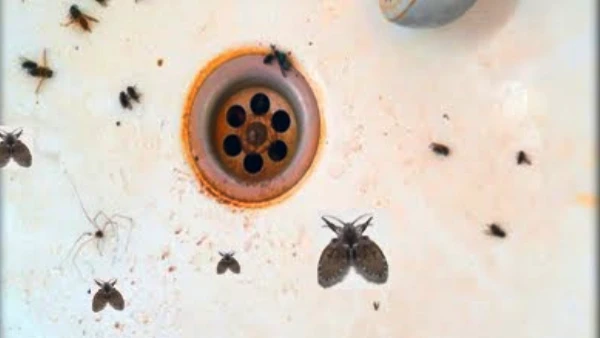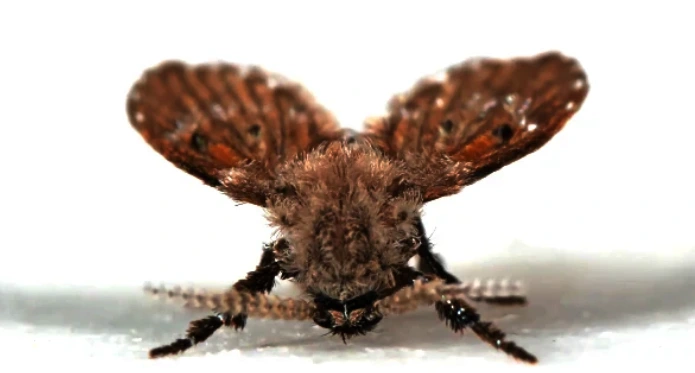Last Updated on November 14, 2023
Small flying insects hanging around your bathroom or kitchen sink are drain flies, also known as moth flies, and they can be difficult to eliminate. These flies can return for various reasons, even after taking several measures to eliminate them.
One reason could be hidden breeding sites in drains that are difficult to clean thoroughly, allowing the flies to reproduce and continue infesting the area. Also, drain flies have resilient eggs and larvae that can survive after cleaning, leading to their return.
Another factor could be the buildup of organic material in the drains, providing a food source for the flies and attracting them back. Here, we’ll explore the possible reasons behind drain fly infestations and share the knowledge to eliminate them. So, let’s get started.
Why Do Drain Flies Keep Coming Back: Reasons to Think About

You may wonder why drain flies keep returning, although you have recently cleaned your drain. There could be several possible reasons for their persistence, such as:
- Hidden breeding sites in drains
- Resilient eggs and larvae
- Organic material buildup
- Incomplete previous cleaning
- Untreated nearby sources
- Cross-contamination
- Cracks and gaps
- Poor drainage and hygiene
- Reintroduction from outside
- Nearby food sources
- Lack of regular cleaning and maintenance
1. Hidden Breeding Sites in Drains
These pesky drain flies tend to be notorious for finding hard-to-reach areas within your plumbing system to lay their eggs. This allows them to rebound even after you’ve cleaned the visible surfaces. These drain flies require moisture and organic matter to survive and reproduce.
Therefore, any stagnant water or organic debris in your drains can be a perfect breeding ground for them. Check your drains regularly for any hidden breeding sites contributing to the persistent presence of drain flies.
2. Resilient Eggs and Larvae
You can’t underestimate the resilience of drain fly eggs and larvae, as they can persist and contribute to recurring infestation. These tiny pests can survive and thrive in the most unfavorable conditions, making them a persistent problem for homeowners.
Even if you eliminate the adult flies, the remaining eggs and larvae can quickly reestablish the infestation. Drain flies are known for laying their eggs in moist and organic-rich areas, such as drains, pipes, and sewage systems. These breeding sites provide the perfect environment for the eggs and larvae to develop and multiply.
3. Organic Material Buildup
Drain flies are attracted to organic matter accumulation in drains and pipes, such as food particles, grease, and hair. These substances provide a constant source of food for the drain flies, which is why they keep coming back. They will keep coming back if there is a constant food source.
4. Incomplete Previous Cleaning
Drain flies lay their eggs in the macro-organisms that accumulate in your drains, such as hair, soap scum, and food particles. By not thoroughly cleaning out your drains and removing all the organic material, you risk the incomplete eradication of drain flies and their subsequent return.
When these eggs hatch, they become larvae that feed on the organic material. If you only partially clean your drains, you may leave behind some of this biological matter, providing a breeding ground for the remaining drain fly larvae or adults.
5. Untreated Nearby Sources
If drain flies keep returning, it could be due to untreated nearby sources like sewage systems or septic tanks. These external sources can provide the ideal breeding grounds for drain flies, allowing them to multiply and infest your drains repeatedly.
6. Cross-contamination
Cross-contamination occurs when drain flies travel from one location to another, potentially hitching a ride on clothing, pets, or other items. This means that if you’ve recently been in an environment with drain flies, they could easily be reintroduced to your home.
7. Cracks and Gaps
Cracks and gaps in your plumbing system provide drain flies with a perfect breeding ground. These small insects can easily enter your home through even the tiniest openings. You must check for any cracks or gaps in your pipes or drainage system to understand why drain flies return.
8. Poor Drainage and Hygiene
Inadequate drainage systems provide the perfect nesting ground for these pests. Clogs in your drains can lead to stagnant water, an ideal environment for drain flies to lay their eggs. Also, accumulating organic matter, such as food particles or hair, can attract drain flies and provide a food source.
9. Reintroduction from Outside
If your windows or doors aren’t properly sealed, drain flies can easily reintroduce themselves from outside into your home. These tiny pests can squeeze through even the most minute cracks and find their way back in.
10. Nearby Food Sources
Having food residue and improperly stored food nearby can lead to continuous breeding and returning drain flies. These tiny pests are attracted to decaying debris; they’ll return if they find a food source in your home.
Trash cans that aren’t properly sealed or cleaned regularly can provide the perfect breeding ground for drain flies. Similarly, drain flies can easily access food and lay their eggs if you have food not stored in airtight containers.
11. Lack of Regular Cleaning and Maintenance
Lack of routine cleaning and maintenance is one of the main reasons why drain flies keep coming back. These tiny pests are naturally drawn to cellulose and moisture, making your drains the perfect breeding ground.
When drains aren’t cleaned regularly, food particles, grease, and other debris can accumulate, providing a constant food source for drain flies. Also, drains that aren’t properly maintained may have stagnant water or leaks, creating a moist environment in which drain flies thrive.
How long does a drain fly invasion last?

Drain fly infestations can typically last for about two weeks. Understanding the life cycle of these pesky insects can shed light on why they keep coming back.
Adult females drop their eggs in sludge found near sewage and drainage sites, where the eggs will hatch within 32 to 48 hours. The larval stage can last 8 to 24 days, followed by a pupal stage lasting 20 to 40 hours.
After this, adult drain flies emerge and live for about two weeks. This cycle repeats itself, explaining the recurring nature of these infestations.
How do I get rid of recurring drain flies?
If you’re dealing with recurring drain flies, you should take a professional and informative approach to eliminate them for good.
The first thing you need to do is identify where the drain flies have been breeding. They typically lay eggs in organic material that accumulates inside your drains or pipes, so start by checking your kitchen and bathroom sinks and floor drains for any signs of larvae or adult flies.
Once you’ve identified the source, create a mixture of salt, baking soda, and vinegar and pour it down the drain. Let it stand overnight, and flush the drain with hot water in the morning.
To prevent future infestations, establish a regular cleaning routine for your drains. Consider using a drain cleaner or repeating the baking soda and vinegar mixture at least once a month to keep your drains clear.
Prevent Drain Fly Infestations by Tackling the Root Cause
Drain fly infestations are extremely annoying, especially when they keep coming back. The causes can be hidden breeding sites, resilient eggs and larvae, organic material buildup, and untreated nearby sources.
You can effectively eliminate drain flies and prevent their return by identifying and addressing the root cause, implementing preventative measures, and regularly cleaning.
Keep your drains clean to prevent problems. And don’t let these tiny pests take over your home. Take proactive steps to keep them at bay.

